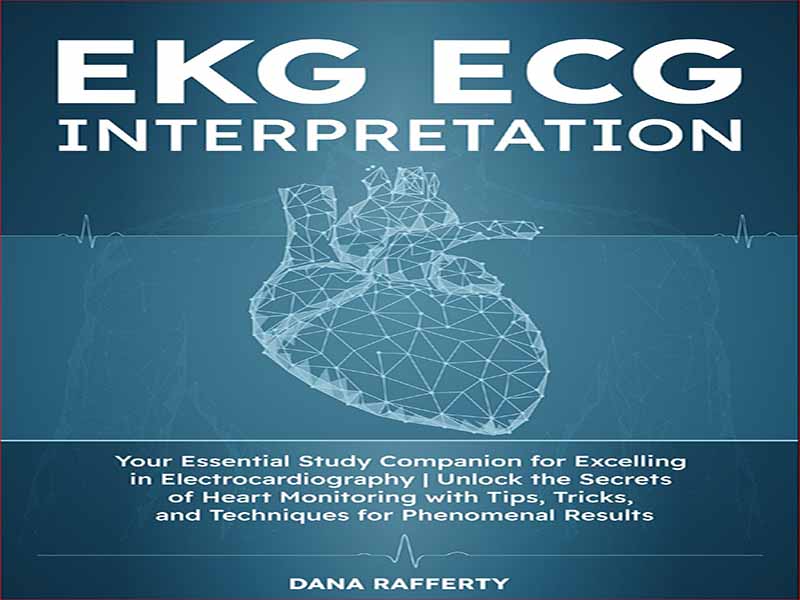- عنوان کتاب: EKG | ECG Interpretation
- نویسنده: Dana Rafferty
- حوزه: قلب و عروق
- تعداد صفحه: 52
- سال انتشار: 2023
- زبان اصلی: انگلیسی
- نوع فایل: pdf
- حجم فایل: 0.85 مگابایت
الکتروکاردیوگرام (EKG یا ECG)، که به طور گسترده به عنوان یک ابزار تشخیصی حیاتی در عمل پزشکی معاصر شناخته شده است، برای ثبت و ثبت تکانه های الکتریکی تولید شده توسط قلب استفاده می شود. نامهای EKG و ECG مترادف هستند و “EKG” از اصطلاح آلمانی “الکتروکاردیوگرام” نشات میگیرد. استفاده از این درمان غیر تهاجمی در شناسایی چندین بیماری قلبی، شامل آریتمی، انفارکتوس میوکارد و ناهنجاری های مادرزادی قلب اهمیت قابل توجهی دارد. قلب اساساً یک اندام عضلانی تخصصی است که هدف اصلی آن گردش خون در سراسر بدن است و از این رو اکسیژن و مواد مغذی ضروری را برای بافت های مختلف فراهم می کند. این فرآیند با یک سری پیچیده از انقباضات و آرامش ها، که توسط یک سیستم هدایت الکتریکی پیچیده هماهنگ شده است، انجام می شود. شروع هر ضربان قلب به ضربه الکتریکی که از گره سینوسی دهلیزی (SA) که در دهلیز راست واقع شده است، نسبت داده می شود. متعاقباً، تکانه فوق الذکر در سراسر دهلیزها منتشر می شود و باعث انقباض آنها و تسهیل حرکت خون به داخل بطن ها می شود. پس از این، سیگنال الکتریکی به گره دهلیزی بطنی (AV) می رود، جایی که تاخیر جزئی رخ می دهد و پر شدن کامل بطن ها با خون را تسهیل می کند. متعاقباً، تکانه الکتریکی در دسته His منتشر میشود، به رشتههای پورکنژ منشعب میشود و انقباض بطنها را آغاز میکند، بنابراین گردش خون به هر دو سیستم گردش خون سیستمیک و ریوی را تسهیل میکند. الکتروکاردیوگرام (EKG) فعالیت های الکتریکی قلب را به شکل موج های متمایز، یعنی موج P، کمپلکس QRS و موج T ثبت می کند. موج P نشان دهنده دپلاریزاسیون الکتریکی دهلیزها است که انقباض آنها را آغاز می کند. کمپلکس QRS منعکس کننده دپلاریزاسیون الکتریکی بطن ها است که باعث انقباض آنها می شود. در نهایت، موج T مربوط به فازی است که طی آن بطن ها برای آماده شدن برای چرخه قلبی بعدی، مجدداً قطبی می شوند.
The electrocardiogram (EKG or ECG), widely recognized as a crucial diagnostic instrument in contemporary medical practice, is employed to capture and document the electrical impulses generated by the heart. The names EKG and ECG are synonymous, with ‘EKG’ originating from the German term “Electrocardiograms.” The use of this non-invasive treatment holds significant importance in the identification of several cardiac ailments, encompassing arrhythmias, myocardial infarctions, and congenital heart anomalies. The heart, fundamentally, is a specialized muscular organ that has the primary purpose of circulating blood throughout the body, hence providing essential oxygen and nutrients to various tissues. This process is accomplished by a sophisticated series of contractions and relaxations, coordinated by a complicated electrical conduction system. The initiation of each heartbeat is attributed to the electrical impulse that starts from the sinoatrial (SA) node, which is situated in the right atrium. Subsequently, the aforementioned impulse propagates across the atria, inducing their contraction and facilitating the propulsion of blood into the ventricles. Following this, the electrical signal proceeds to the atrioventricular (AV) node, where a slight delay occurs, facilitating the full filling of the ventricles with blood. Subsequently, the electrical impulse propagates down the bundle of His, bifurcates into the Purkinje fibers, and initiates the contraction of the ventricles, so facilitating the circulation of blood to both the systemic and pulmonary circulatory systems. The electrocardiogram (EKG) records the electrical activities of the heart in the form of distinct waveforms, namely the P wave, the QRS complex, and the T wave. The P wave signifies the electrical depolarization of the atria, which initiates their contraction. The QRS complex reflects the electrical depolarization of the ventricles, which triggers their contraction. Lastly, the T wave corresponds to the phase during which the ventricles repolarize in preparation for the subsequent cardiac cycle.
این کتاب را میتوانید بصورت رایگان از لینک زیر دانلود نمایید.
Download: EKG | ECG Interpretation

































نظرات کاربران